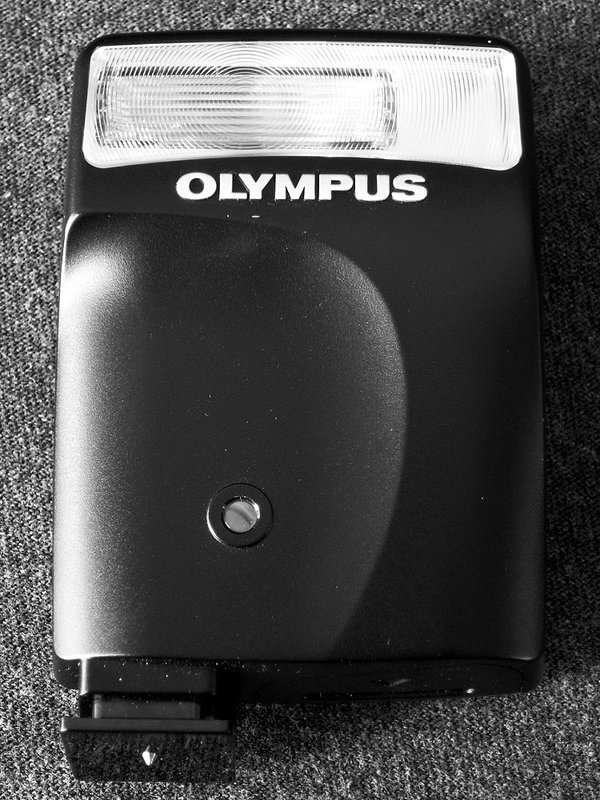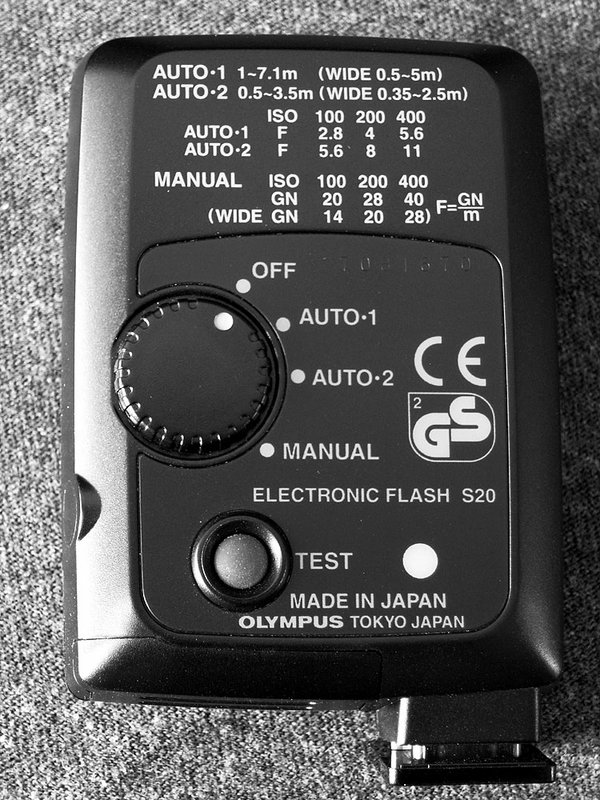I've been using this little flash for some time now and I thought I'd post a mini-review. I discovered this unit after extensive research into the "perfect" flash for my Ricoh GX100. My criteria were pretty stringent: the flash had to be small so as to balance well with the camera; it had to be usable in automatic mode since the GX100 has no TTL flash function; it had to use readily available batteries, preferably AA or AAA; and it had to cover the 24mm wide end of the GX100's zoom. I also didn't want any auto-off "feature" as I dislike missing shots due to the flash falling asleep. I found only one flash that met all these criteria, and that flash, the Olympus S20, is the subject of this review.
The front of the flash is spartan in appearance. You can see the circular electric eye sensor in the lower area. Note that the foot has only a single pin. There is no TTL function and thus the flash can be used with any camera that has an ISO standard hotshoe, with exposure controlled automatically through the electric eye. The flash is literally the size of a pack of cigarettes. At 56 x 82 x 28mm and 70g, it slips easily into a shirt pocket and you'll barely even notice it.
The rear view of the flash shows its exposure guide and simple control dial. The guide is self-explanatory: in Auto-1 setting, at f/2.8 and ISO 100 the flash has an effective range of 1 to 7.1m (or 0.5 to 5m with the 24mm wide adapter attached); and in Auto-2 setting, at f/5.6 and ISO 100 the range is 0.5 to 3.5m (or 0.35 to 2.5m with the wide adapter attached). There is also a full manual mode. Below the control dial are the test button and ready light. At the lower left you can see the seam of the sliding door that covers the battery chamber. The S20 takes two AA batteries.
The crowning glory of the S20 is its 24mm wide angle adapter, which enables it to fully cover the wide end of the GX100 and GX200 lens. This accessory simply snaps into two retaining holes on the sides of the flash unit. If you're really creative you can buy all sorts of color correction gels, cut them to size and slip them behind the adapter. The flash is safe to use with electronic cameras, with a trigger voltage of 10V.
The flash is actually made in Japan by Matsushita (parent company of Panasonic). This same flash has been rebranded in at least two other instances of which I'm aware: 1) as the Leica CF flash for the Minilux Zoom; and 2) as the Konica HX-18W for the Hexar RF M-mount rangefinder. The only real difference is that the non-Olympus versions do not include the 24mm wide angle filter.
(Review continued in next post with sample pictures)
The front of the flash is spartan in appearance. You can see the circular electric eye sensor in the lower area. Note that the foot has only a single pin. There is no TTL function and thus the flash can be used with any camera that has an ISO standard hotshoe, with exposure controlled automatically through the electric eye. The flash is literally the size of a pack of cigarettes. At 56 x 82 x 28mm and 70g, it slips easily into a shirt pocket and you'll barely even notice it.
The rear view of the flash shows its exposure guide and simple control dial. The guide is self-explanatory: in Auto-1 setting, at f/2.8 and ISO 100 the flash has an effective range of 1 to 7.1m (or 0.5 to 5m with the 24mm wide adapter attached); and in Auto-2 setting, at f/5.6 and ISO 100 the range is 0.5 to 3.5m (or 0.35 to 2.5m with the wide adapter attached). There is also a full manual mode. Below the control dial are the test button and ready light. At the lower left you can see the seam of the sliding door that covers the battery chamber. The S20 takes two AA batteries.
The crowning glory of the S20 is its 24mm wide angle adapter, which enables it to fully cover the wide end of the GX100 and GX200 lens. This accessory simply snaps into two retaining holes on the sides of the flash unit. If you're really creative you can buy all sorts of color correction gels, cut them to size and slip them behind the adapter. The flash is safe to use with electronic cameras, with a trigger voltage of 10V.
The flash is actually made in Japan by Matsushita (parent company of Panasonic). This same flash has been rebranded in at least two other instances of which I'm aware: 1) as the Leica CF flash for the Minilux Zoom; and 2) as the Konica HX-18W for the Hexar RF M-mount rangefinder. The only real difference is that the non-Olympus versions do not include the 24mm wide angle filter.
(Review continued in next post with sample pictures)


